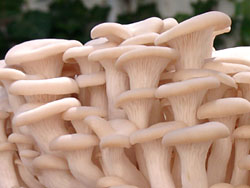Summer oyster mushroom (Pleurotus ostreatus fm. florida)

Summer oyster mushroom var. "Florida"
This cream coloured variety of the oyster mushroom only grows fruiting bodies when it is warm. In contrast to the "normal" oyster mushroom (the so-called whole year variety which we sell), it does not need a "cold shock" to grow fruiting bodies, i.e. you nearly always tend to get this mushroom type during the summer months.
In contrast, the whole year variety of the oyster mushroom (Pleurotus ostreatus) also grows mushrooms in the summer, but only when the temperature drops (e.g. on cold days with rain after a long hot period). The summer oyster mushroom can be grown on wood and straw. Inoculated logs are frost resistant.
Profile of the summer oyster mushroom |
Taste and preparation:
Oyster mushrooms do not have much of a taste of their own, so you can season them according to your own taste and also add herbs. It is a good mushroom for all types of dishes, whether in sauces, vegetable dishes or fried with onions and herbs. Larger individual mushrooms can even be coated with seasoned breadcrumbs before frying.
Large and small fruiting bodies are harvested together as bunches or clusters. Don't cut up the individual mushrooms too small, since they shrink a lot during cooking or frying, just like all mushrooms.
The caps of each of the mushrooms joins onto the stalks without a clear division. In the case of larger mushrooms, you can cut out and remove the thicker part of the stalk because it can be quite tough to eat
|
Production and marketing:
Very popular on the marketplace alongside champignons. This mushroom is normally grown on substrate blocks in mushroom farms in Germany and neighbouring countries (especially the Netherlands and Poland). |
Growing in the garden:
Easy to grow on logs, straw bales or straw pallets. The fruiting bodies appear above all in the warm season.
|
Our products:
Grain spawn for summer oyster mushrooms |
|